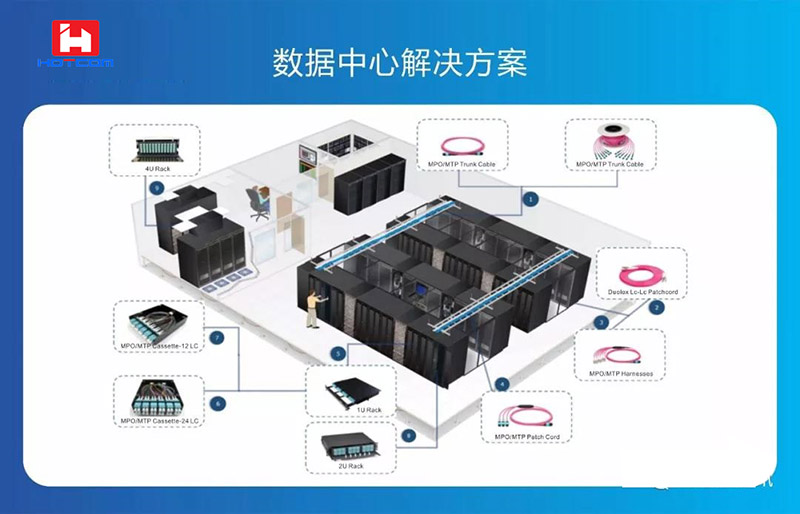Application of MPO/MTP optical cable in data center
2020/1/6 15:17:54
In order to meet the needs of high-density interconnection wiring in high-speed and large capacity data centers, the traditional single core SC fiber connector and dual core LC fiber connector are gradually replaced by high-density multi-core fiber connector. At present, MPO or MTP are usually used in the industry. MPO is the abbreviation of multi fiber push on / pull off, which means multi-core push-pull self-locking optical fiber connector. It was invented by usconec company. MTP is the brand of MPO connector registered by usconec company, especially its high-performance MPO connector.
Compared with ordinary optical cable, the main characteristics of MPO/MTP optical cable are high density and pre connection, which is finally reflected in MTP / MPO multi-core connector. Throughout the development of the industry, there are two obvious development stages of optical fiber connector: the first stage is to save space and develop towards miniaturization. Optical fiber connector has developed from traditional FC, St, SC to LC, MTRJ. In the second stage, not only to save space, but also to meet the requirements of multi-core use, the optical fiber connector evolved from LC, MTRJ to mu, MTP / MPO. At present, a MTP / MPO multi-core joint can meet the high density requirements of 12 core, 24 core, 72 core, etc. What's more, MTP / MPO cable realizes the multi-core pre connection of a single fiber through the equipment and assembly line in the factory, replacing the complex field termination work, which not only greatly reduces the field installation time, but also greatly reduces the installation space of the wiring system, and also reduces the impact of field construction and installation on performance and the probability of performance uncertainty.
In summary, the advantages of applying MPO / MTP fiber optic cable in data center are as follows: (1) protecting the effectiveness and safety of investment. Although the application of MPO / MTP fiber optic cable puts forward higher requirements for the early stage and actual field investigation ability of integrators, it can also fully protect the investor's right of control over the project and the right to know about the use of products, avoid material waste and the wind of project investment Insurance; (2) economical and applicable, in general, MPO / MTP pre connection mode does not increase additional cost; (3) easy to operate, easy to install, and save installation time, which can be plug and play. We can make a simple comparison, for example, laying a 288 core optical cable, 3 construction workers, 2 sets of equipment, using the traditional fiber melting method, laying takes about 2 hours, and the time of fiber melting plus installation takes about 8 hours, a total of about 10 hours. If MPO / MTP is used to pre connect the optical cable, the laying time is still 2 hours, but the installation time is greatly reduced, only about 4 hours 5 minutes, which undoubtedly has a huge advantage in time cost; (4) MPO / MTP pre connected optical fiber cable is completely tested in the factory, and there is no additional product during the installation process, so the field test operation is simple; (5) the optical fiber link is fully protected, there is no fusion point and bare optical fiber exposed in the air, and there is no aging, joint fracture and other problems; (6) convenient maintenance and safety All in all, the mechanical performance of the MPO/MTP pre connected optical fiber brancher is excellent, and the maintenance or operation process will not affect the normal use of the optical fiber; (7) it can be reinstalled and moved, and the MPO/MTP pre connected optical fiber brancher can be quickly plugged and moved, and reinstalled as required.
Although MPO / MTP cable brings many benefits in engineering implementation through end-to-end high-density integration and plug and play implementation, it is still necessary to measure whether it has the ability to support smooth network upgrading. We know that the cabling system of a data center can't be used for only 5-10 years. Compared with the network equipment, the lifetime of the cabling system is much longer. Therefore, when planning the cabling system of the data center, we should consider the ability of upgrading and expanding the network in the future. With the data center moving from 10g to 100g, the traditional LC type port connection mode will not be able to meet the demand, while MPO / MTP can do it easily. Under IEEE 802.3ba standard, MPO / MTP can realize 100g in two ways, that is: (1) one 24 core MPO optical cable and connector, of which 10 cores are used to send signals, and the other 10 cores are used to receive signals, so that 10 10g parallel optical links constitute one 100g optical link; (2) two 12 core MPO optical cables and connectors, of which 10 cores of one MPO optical cable are used to send signals and the other M The 10 cores of Po optical cable are used to receive signals. Similarly, 10 10g parallel optical links constitute one 100g optical link. In IEEE 802.3bm standard, 8-core MPO optical cable and its connector can also be used to realize the parallel transmission of 4 25g optical channels. To sum up, MPO / MTP has good adaptability for network upgrading and capacity expansion.
When selecting MPO / MTP optical cable, in addition to meeting the design requirements, the most important thing is to pay attention to whether the factory of MPO / MTP optical cable manufacturer conforms to a series of quality management system certification such as ISO 9000, and whether its production process and product performance conform to the current industry standard certification for the production of optical fiber connection components. The MPO/MTP cable produced by H&T meets the above purchase requirements and will be one of the preferred cabling products for you to build a green and efficient data center.



